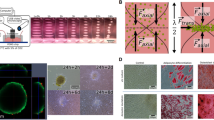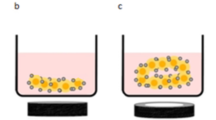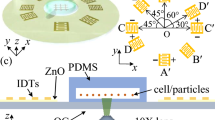Abstract
Three-dimensional (3D) cell structures are required to fabricate artificial organ. Inkjet technology is applied for fabrication of 3D cell structures in order to fabricate artificial organ and investigate biochemical characteristics of cells in 3D cell structures. Usually cells located inside 3D cell structures get nutrition via blood vessels. In case that there are no blood vessels in the 3D cell structures, cells located inside the 3D cell structures will die of nutrition shortage. So, blood vessels are essential to fabricate 3D cell structures. When the amount and flow of nutrition is controlled, growth speed of cells will be changed. We control the flow around the cells utilizing magnetic particles and magnetic force. The magnetic particles are installed in the dish that is filled with medium, nutrition and living cells. When the magnetic particles are trapped and transported by magnetic force, the cell growth will be controlled. In this paper, we challenge to control the flow utilizing magnetic particles and magnetic force.








Similar content being viewed by others
Explore related subjects
Discover the latest articles, news and stories from top researchers in related subjects.References
Nakamura M, Nishiyama Y, Henmi C, Iwanaga S, Nakagawa H, Yamaguchi K, Akita K, Mochiuki S, Takiura K (2008) Ink jet three-dimensional digital fabrication for biological tissue manufacturing: analysis of alginate microgel beads produced by ink jet droplets for three dimensional tissue fabrication. J Imaging Sci Technol 52(6):060201–060206
Chan LW, Lee HY, Heng PWS (2006) Mechanism of external and internal gelation and their impact on the functions of alginate as a coat and delivery system. Carbohydr polym 63:176–187
Chan ES, Lim TK, Voo WP, Pogaku R, Tey BT, Zhang Z (2011) Effect of formulation of alginate beads on their mechanical behavior and stiffness. Part 9(3):228–234
Cuadros TR, Skurtys O, Aguilera JM (2012) Mechanical properties of calcium alginate fibers produced with a microfluidic device. Carbohydr polym 89:1198–1206
Umezu S, Kitajima T, Ohmori H, Ito Y (2011) Fundamental characteristics of printed cell structures utilizing electrostatic inkjet phenomena. Sens Actuators A: phys 166(2): 251–255
Umezu S (2011) BioCell print utilizing patterning with electrostatically injected droplet (PELID) method. J artif Life Robot 17(1): 59–62
Umezu S, Hatta T, Ohmori H (2013) Fundamental characteristics of bioprint on calcium alginate gel. Jpn J Appl Phys 52(5S1):05DB20
Umezu S, Kunugi Y, Ohmori H (2013) Dye-sensitized solar cell utilizing electrostatic inkjet. Jpn J Appl Phys 52(5S1):05DC23
Gijs AMM (2004) Magnetic bead handling on-chip: new opportunities for analytical applications. Microfluid Nanofluidics 1(1): 22–40
Ino K, Ito A, Honda H (2007) Cell patterning using magnetite nanoparticles and magnetic force. 97(5):1309–1317
Author information
Authors and Affiliations
Corresponding author
About this article
Cite this article
Umezu, S. Flow control for cell growth by movement of magnetic particles utilizing electromagnetic force. Artif Life Robotics 21, 1–4 (2016). https://doi.org/10.1007/s10015-016-0261-1
Received:
Accepted:
Published:
Issue Date:
DOI: https://doi.org/10.1007/s10015-016-0261-1




